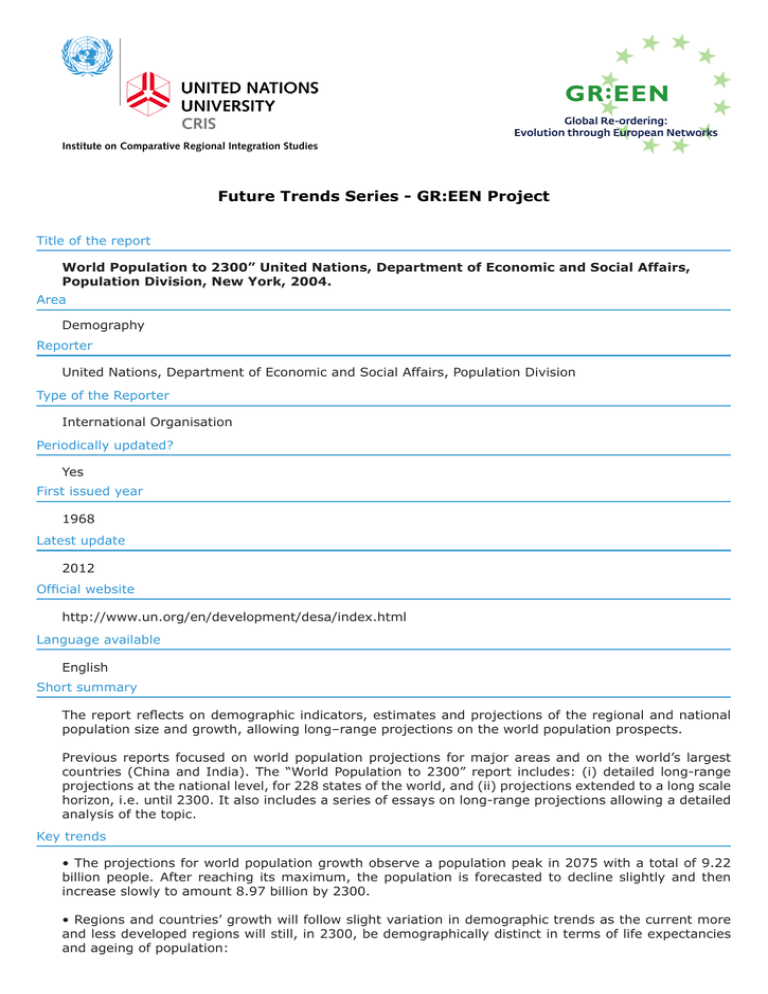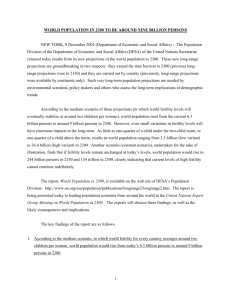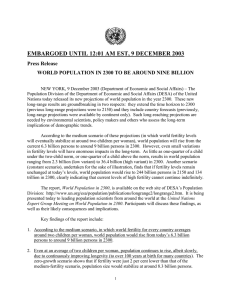Future Trends Series - GR:EEN Project
advertisement

Future Trends Series - GR:EEN Project Title of the report World Population to 2300” United Nations, Department of Economic and Social Affairs, Population Division, New York, 2004. Area Demography Reporter United Nations, Department of Economic and Social Affairs, Population Division Type of the Reporter International Organisation Periodically updated? Yes First issued year 1968 Latest update 2012 Official website http://www.un.org/en/development/desa/index.html Language available English Short summary The report reflects on demographic indicators, estimates and projections of the regional and national population size and growth, allowing long–range projections on the world population prospects. Previous reports focused on world population projections for major areas and on the world’s largest countries (China and India). The “World Population to 2300” report includes: (i) detailed long-range projections at the national level, for 228 states of the world, and (ii) projections extended to a long scale horizon, i.e. until 2300. It also includes a series of essays on long-range projections allowing a detailed analysis of the topic. Key trends • The projections for world population growth observe a population peak in 2075 with a total of 9.22 billion people. After reaching its maximum, the population is forecasted to decline slightly and then increase slowly to amount 8.97 billion by 2300. • Regions and countries’ growth will follow slight variation in demographic trends as the current more and less developed regions will still, in 2300, be demographically distinct in terms of life expectancies and ageing of population: • Europe will see its shares of world population decreasing by half from 2000 to 2100, decreasing from 12.0 per cent to 5.9 per cent; • Africa grows from 13.1 per cent to 24.9 per cent; • Asian regions will be 2.2 times as populous as Africa by 2100; • Latin America and the Caribbean is the most homogenous area with parallel fertility and life expectancies rates; North America will experience no negative growth due to migration patterns projected up to 2050. • Globally, life expectancy will continue to rise. By 2300 life expectancy will vary from 87 to 106 years, causing continuing population growth ranging from 0.03 per cent to 0.07 per cent annually. • Those growth patterns are likely to affect the balance between population and land. Density in people per square kilometre of land will continue to be variable as by 2100, 504 persons per sq. km will be accounted in Micronesia, 3.6 persons per sq. m in Australia and New Zealand for the Oceania region. The same disparity will be observed for South Asia as India will have 491 persons per sq. k while Bangladesh has rates reaching 1,997 persons per sq. feet. Suggestions / Methodology Modelling Reference to other trends reports? If yes, which reports? /




